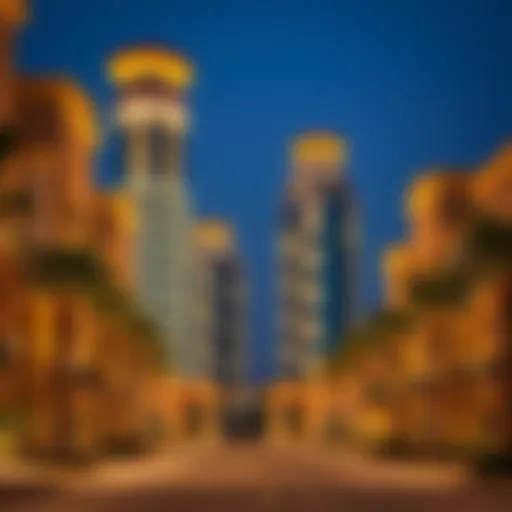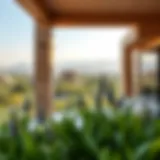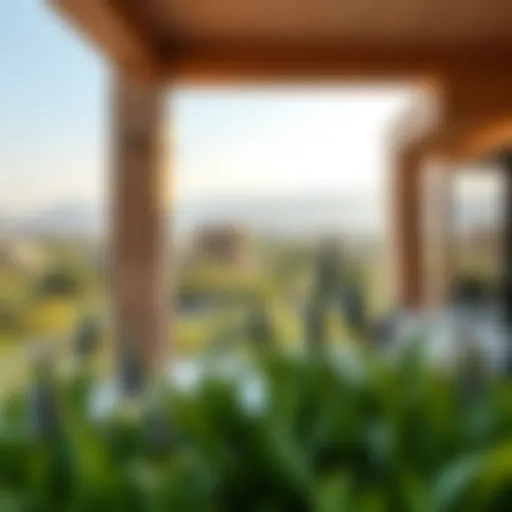The Burj Khalifa Shopping Mall: A Unique Blend of Architecture and Commerce
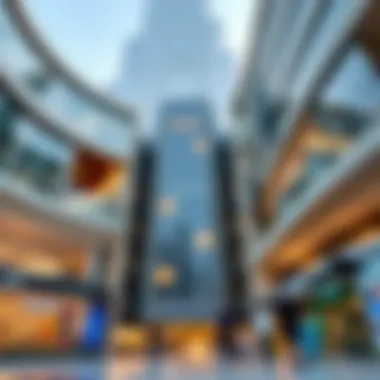

Intro
The Burj Khalifa shopping mall, seamlessly integrated within the towering presence of the Burj Khalifa in Dubai, stands as a testament to modern architecture and commercial audacity. The extraordinary design coupled with a diverse retail environment creates a unique shopping experience that’s hard to rival. This article delves into the intricate details of the mall, analyzing its architectural merit and the significant role it plays in Dubai's economy and real estate market.
Market Trends
As we peer into the landscape of Dubai’s retail sector, it's clear that the Burj Khalifa shopping mall not only leads but also reflects the overarching trends shaping consumer behavior. There's been a noticeable surge in luxury consumption, particularly amongst affluent expatriates and tourists. The rise of social media also shapes retail experiences, as shoppers are often on the hunt for unique, Instagram-worthy spots within the mall.
Current Trends and Predictions
Recent data suggests that high-end retail is on the upswing, with brands expanding their footprints in the mall. Shoppers are increasingly gravitating towards experiential shopping—where the act of purchasing is just one element of a broader experience.
- Personalized shopping services are becoming more common.
- Interactive displays and immersive environments draw shoppers in.
- Sustainable and ethically sourced luxury items are gaining traction.
Predictions for the future indicate that the mall could see a vibrant influx of international brands seeking a foothold in Dubai's lucrative market. As the tourist influx continues post-pandemic, the shopportunities are likely to expand.
Analysis of Price Fluctuations
Price fluctuations within the mall are also an interesting case to study. Retail prices for luxury goods can vary due to factors such as currency exchange rates and import taxes. The dynamic nature of global economics can lead to significant changes in what consumers pay. Local brands often benefit from an emotional connection to the culture, while international brands command premium prices due to their exclusivity. The intricate dance of pricing strategies here plays a part in shaping consumer choices and behaviors.
Investment Opportunities
Investing in the Burj Khalifa shopping mall and surrounding areas presents intriguing opportunities for both local and international investors keen on capitalizing on Dubai's thriving economy.
Real Estate Hotspots
Real estate around the Burj Khalifa is consistently sought after, owing to its iconic status. Nearby areas such as Downtown Dubai are hotspots for both residential and commercial investments. Buyers are particularly interested in properties that promise high returns on investment.
- Properties with direct access to the mall are often more desirable.
- Locations that offer mixed-use developments make for a strategic investment.
High-ROI Property Types
When considering what types of properties yield the highest returns, the emphasis is on:
- Luxury apartments that cater to the expatriate market.
- Retail spaces within the mall that attract foot traffic.
- Commercial offices that benefit from the prestige of the Burj Khalifa address.
Investors should stay on top of market evaluations and trends, as timely decisions can lead to financially rewarding results.
The Burj Khalifa shopping mall is not only a retail space; it represents an investment in Dubai’s future.
In summary, understanding the complex interactions between consumer behaviors, architectural beauty, and economic viability creates a holistic view of the Burj Khalifa shopping mall. The mall is both a retail paradise and a symbol of Dubai's ambitions.
Intro to the Burj Khalifa Shopping Mall
The Burj Khalifa Shopping Mall, nestled at the base of the world’s tallest building, isn't just another retail space; it's an experience that encapsulates the essence of modern consumer culture against the backdrop of architectural brilliance. With its monumental presence, the mall represents a convergence of luxury shopping, entertainment, and cultural engagement, making it a key player in Dubai’s retail scene.
When one thinks of the mall, it's essential to grasp its psychological and economic impact on both visitors and the city itself. The sheer scale of the Burj Khalifa towers over not only the skyline but also the expectations of what a shopping experience should deliver. It sets the stage for a unique customer journey, blending leisure with commerce. This environment is designed with precision to invite visitors—from casual shoppers to high-end clientele—into its embrace, making every visit feel special.
Moreover, the shopping mall contributes significantly to Dubai’s economy. It acts as a catalyst for job creation, fostering local startups while drawing in international brands. With its diversified retail offerings, from upscale boutiques to familiar global brands, the mall draws not just tourists but also local residents who seek a convenient and enjoyable shopping experience. The integration of amenities such as dining options and recreational spaces makes it a one-stop destination that transcends mere shopping.
Additionally, understanding the design and spatial layout of the mall provides insight into how it influences consumer behavior. Unlike traditional malls that often feel disjointed, the Burj Khalifa Shopping Mall is meticulously organized to enhance foot traffic and encourage consumers to explore various sections. Such intentional design reflects a thoughtful consideration of what shoppers desire in an upscale environment.
In summary, the Burj Khalifa Shopping Mall is more than a commercial hub; it is a symbol of luxury and innovation. As we delve deeper into the architectural marvel, retail landscape, and broader impact of this shopping destination, it becomes clear that it serves as an essential pillar in Dubai’s ambitious vision for growth and modernity. The upcoming sections will unpack these themes and explore how this shopping mall epitomizes the fusion of architecture and commerce.
Architectural Marvel of Burj Khalifa
The Burj Khalifa is not just a skyscraper; it’s an architectural wonder that redefines the skyline of Dubai and the concept of modern urban design. Standing tall amidst the desert landscape, this structure embodies the fusion of art and engineering. It serves as a catalyst for commercial activities, attracting tourists and investors alike. The importance of studying this architectural marvel lies in understanding how it has shaped not only the city of Dubai but also the global perspective of what is achievable in architecture. From its sheer height to the intricate details that comprise its structure, the Burj Khalifa presents an example of human ingenuity and determination.
Design Principles of the Burj Khalifa
The design principles of the Burj Khalifa draw heavily on Islamic architecture, particularly in the use of geometric patterns and curvilinear forms. The building’s shape is inspired by the hymenocallis flower, which lends an organic flow to its profile. One cannot overlook the significance of its Y-shaped floor plan that efficiently maximizes views of the surrounding area from every angle. This design is not merely for aesthetics; it also plays a crucial role in optimizing wind resistance, an essential factor given the tower’s colossal height. The choice of materials, including reflective glazing and high-strength concrete, further underscores the building's modernity while ensuring its sustainability. Considerations like energy efficiency and environmental impact are woven into the ethos of the design, making it an exemplary model for future architectural endeavors.
Structural Innovations in the Mall
Within the Burj Khalifa, the shopping mall integrates structural innovations that reflect contemporary engineering advancements. The use of a high-performance concrete mix allows the mall to withstand the pressures of high-traffic retail while providing resilience against the elements. This innovation is particularly evident in the use of composite materials that not only reduce the overall structural weight but also enhance durability.
Moreover, the mall employs a sophisticated system of mechanical and electrical services designed for optimal efficiency. Consideration for seismic activity in the design further showcases the engineers' foresight in ensuring safety and functionality. This combination of structural soundness and aesthetic design makes the mall part of a revolutionary architectural framework.
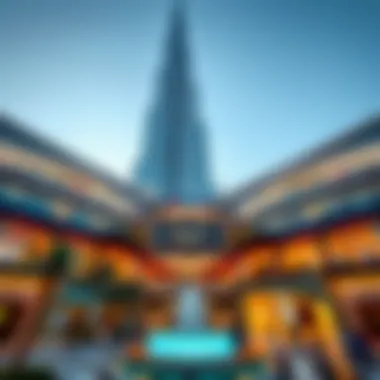

Spatial Layout and Consumer Flow
One of the most significant challenges in designing a shopping mall within such an iconic structure is ensuring effective consumer flow. The Burj Khalifa’s shopping mall addresses this through a well-thought-out spatial layout that encourages exploration and interaction without causing congestion.
Wide corridors and open spaces create an inviting atmosphere, making it easy for visitors to navigate. The strategic placement of anchor stores and dining areas enhances consumer experience, providing natural congregation points. Signage is clear and straightforward, guiding visitors effortlessly from one shopping zone to another. Furthermore, the incorporation of rest areas and observation decks adds layers to the experience, allowing shoppers to both engage in retail therapy and soak in the panoramic views of Dubai.
"The architectural plan maximizes not only aesthetics but also utility, as every element serves a purpose in promoting a seamless shopping experience."
In summary, the architectural elements within the Burj Khalifa harmoniously intersect with commercial functionality, creating a space where consumers are not just shopping but experiencing the very essence of modern retail in a stunning setting.
This architectural marvel showcases how smart design and innovative structural approaches can elevate the shopping experience to new heights.
For more detailed insights on the Burj Khalifa, you may visit Wikipedia and Britannica.
Retail Landscape
The Burj Khalifa shopping mall stands as a beacon of consumerism in a city renowned for its extravagant ambitions. The retail landscape here is not just about shopping; it’s an experience in itself. As such, understanding this landscape is crucial for anyone looking to invest or even visit. The significance goes beyond aesthetics; it is about how the mall encapsulates the essence of luxury and diversified shopping all under one stunning roof.
This mall hosts a range of flagship brands that cater to an elite clientele, while simultaneously providing unique experiences that attract a wider audience. Anchored by high-end stores and luxury offerings, the retail landscape in this mall epitomizes a blend of high street and haute couture, which effectively positions itself as an essential hub for consumers and investors alike.
Flagship Brands and Luxury Offerings
In the heart of the Burj Khalifa shopping mall, flagship stores are a treasure trove for luxury seekers. You can find renowned brands such as Gucci, Louis Vuitton, and Chanel, which offer exclusive collections that often fly off the shelves. What's fascinating is how these luxury retailers enhance the overall experience of the mall. They don’t just sell products; they also curate an atmosphere that reflects opulence.
- Exclusivity: Limited-edition items and personalized experiences can often turn a shopping trip into a collector’s quest.
- Brand Ambassadors: Often, flagship stores feature brand specialists on the floor to engage with customers, offering a bespoke shopping experience that is hard to replicate.
- Ambiance: The interior design of these stores is breathtaking, often closely mirroring the grandeur of the Burj Khalifa itself, drawing visitors not just to shop but to experience the essence of luxury.
For the discerning shopper, these aspects contribute a major share to the retail landscape's allure. It’s less about merely purchasing goods and more about indulging in a lifestyle, a narrative that resonates with many consumers today.
Diverse Shopping Experiences
The Burj Khalifa shopping mall takes pride in its diverse shopping experiences, extending beyond luxury fashion. The layout of the shopping areas allows for exploration across various categories, creating a dynamic environment for all visitors. Whether it’s the latest tech gadgets or unique artisanal crafts, there’s something for every taste and preference.
One striking element of diversity in the shopping experience includes:
- Cultural Retail: Local artisans and traditional stores offering craft goods allow visitors to take a piece of Dubai home, supporting local craftsmanship.
- Integrated Shopping Fairs: What’s even more engaging are the shopping fairs that sometimes pop up, showcasing both local and international products, adding a touch of festivity.
- Experience Zones: Some sections are designed as experience zones, letting visitors try before they buy, significantly enhancing customer engagement.
This diversification is not just for show; it aims to bridge the gap between different consumer worlds, from those seeking lavish luxury to the everyday shopper. By casting a wider net, the Burj Khalifa shopping mall has succeeded in drawing a varied clientele, which in turn boosts footfall and sales, making it a goldmine of opportunities for investors and retailers alike.
"The retail landscape is not merely transactional; it drives the essence of experiences that linger long after the shopping bags are put away."
Navigating through this retail landscape within the Burj Khalifa shopping mall is akin to an exploration of culture, wealth, and consumer dynamics—each shop telling its own story, yet forming part of a larger narrative that defines modern consumer behavior.
Consumer Profiles and Behaviors
Understanding the diverse consumer profiles and behaviors within the Burj Khalifa shopping mall is crucial, as it highlights the unique blend of local and international shopping habits. These distinctions inform retailers, investors, and developers on how to tailor their offerings to fit specific needs and preferences. A deep dive into these behaviors not only unveils market trends but also enhances customer experience, fostering loyalty and driving sales. The insights derived from this analysis can significantly affect marketing strategies and investment decisions, making it essential for stakeholders in the retail sector.
Local vs. International Consumers
The shopping mall attracts a rich tapestry of consumers, split distinctly between local residents and international visitors. Local consumers generally seek convenience, quality, and value, often prioritizing proximity to their homes in Dubai. They tend to frequent the mall for both everyday needs and leisure activities. On the other hand, international visitors come with different motives, often rooted in the allure of luxury brands and unique shopping experiences that are synonymous with Dubai's global reputation.
Key considerations include:
- Shopping purpose: Locals may shop more for utility, while tourists might indulge in splurging on luxury items.
- Cultural influences: Local customs and traditions impact shopping choices, such as seasonal shopping festivals during Ramadan. In contrast, international consumers often show a preference for brands not available in their home countries.
- Price sensitivity: Local residents might be more attuned to promotions and discounts, while international shoppers may be willing to pay a premium for exclusivity.
Understanding these local and international dynamics can help businesses cater to both audiences effectively, ensuring that they feel valued and understood in their retail experience. This dual approach ensures a vibrant shopping environment that caters to all.
Trends in Consumer Preferences
Recent trends indicate a shift in consumer preferences that reflect broader changes in society, technology, and culture. The growth of e-commerce has not negated the appeal of physical shopping; rather, it has changed how consumers interact with retail spaces. Shoppers are looking for immersive experiences, not just transactions, leading to a demand for more engaging retail environments.
Some notable trends include:
- Experiential Retail: Consumers are increasingly drawn to brands that offer not just products, but experiences. Interactive installations and events attract foot traffic and increase dwell time.
- Sustainability Focus: There is a growing consciousness around eco-friendly practices. Shoppers prefer brands that demonstrate a commitment to sustainability, influencing their purchasing decisions significantly.
- Technology Integration: The adoption of technology in retail, such as augmented reality and mobile shopping apps, is on the rise. Consumers expect seamless integration of tech into their shopping journey, from payment options to personalized marketing strategies.
"Understanding consumer preferences is just as vital as recognizing the economic impact of shopping centers. This awareness shapes not only what retail looks like today, but also how it will evolve in the future."
By staying attuned to these trends, the Burj Khalifa shopping mall can position itself as a forward-thinking retail environment that embraces both local and international consumers. Continuous adaptation and responsiveness to these consumer behaviors and preferences will be key to maintaining relevance and success.
Investment Opportunities
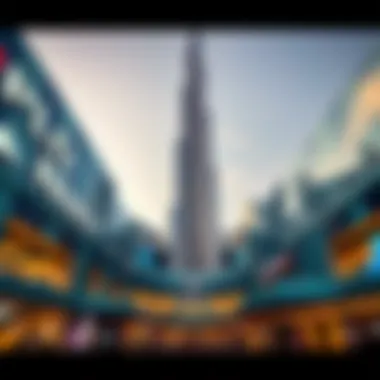

The Burj Khalifa shopping mall stands as a pivotal element within the broader economic scope of Dubai, attracting not just consumers but potential investors from every corner of the globe. In this rich tapestry of commerce and architecture, the mall presents a plethora of investment opportunities that can cater to various levels and sectors within the market. Its unique positioning calls for an exploration of what makes this space so appealing to buyers, agents, and developers alike.
Attractiveness for Investors
Investors looking for prime real estate opportunities will find the Burj Khalifa shopping mall exceptionally enticing. This isn't just another retail space; it represents a blend of luxury and accessibility that is rare and valuable. The high foot traffic from both locals and tourists speaks volumes about its potential for substantial returns on investment.
Moreover, the surrounding infrastructure enhances the appeal — excellent transport links, high visibility, and proximity to key tourist attractions all contribute to an environment that's ripe for commercial success.
Factors worth considering include:
- Prestige of Location: The Burj Khalifa and its mall are iconic; owning property here translates to credibility and status.
- Diverse Consumer Base: From wealthier expatriates to curious tourists, the mall attracts a varied demographic, expanding the potential customer base.
- High-Quality Retail Environment: With many flagship brands and luxury offerings, investors can benefit from premium retail spaces that command higher rents.
Market Trends and Outlook
As the world gradually emerges from economic disruptions, the retail landscape, especially in luxury sectors, is witnessing a marked recovery. The Burj Khalifa shopping mall is no exception. Recent studies show a resurgence in consumer spending as confidence begins to return, fueling optimism about the future of retail in Dubai.
In terms of market trends:
- Expansion of E-commerce: The mall has been integrating online and offline experiences, enhancing convenience and attracting tech-savvy consumers.
- Sustainability Trends: Modern consumers are increasingly leaning towards brands that prioritize sustainability, prompting many retailers within the mall to adopt eco-friendly practices that resonate well with today’s shoppers.
- Cultural Engagement: The ongoing embrace of local culture within the retail sector is also notable; this can attract consumers looking for unique souvenirs and authentic experiences.
Looking forward, myriad opportunities lie in understanding consumer behaviors, and capitalizing on the shifting trends will be essential for those looking to invest in this vibrant market.
Investment in the Burj Khalifa shopping mall isn’t just about purchasing retail space; it’s about buying into a vision for the future of luxury retail in Dubai.
For more information on market trends and investment insights in Dubai, visit resources like Dubai Economic Department or Khaleej Times.
Economic Impact on the Local Market
The Burj Khalifa Shopping Mall has made ripples in the local economy, not just as a shopping destination but also as a significant player in the commercial landscape of Dubai. By intertwining the worlds of architecture and commerce, this mall has created an economic tapestry that benefits a myriad of stakeholders. Understanding its impact involves dissecting the aspects of employment generation, job growth, and how it drives the real estate market in the region.
Employment Generation and Job Growth
The sheer scale of the Burj Khalifa Shopping Mall has brought about an influx of job opportunities that umbrella a variety of sectors. Over the years, thousands of positions have sprouted, ranging from retail staff to managerial roles, alongside jobs in maintenance, security, and hospitality. This surge has multiple layers:
- Diverse Job Roles: The mall caters to a blend of luxury brands and unique shops, creating varied roles that demand different skill levels. For instance, high-end brands requiring boutique consultants will differ from fast fashion retail jobs, thereby appealing to a wider workforce.
- Training and Development: With the mall’s establishment, program initiatives to upskill workers have gained traction. Training partnerships with local institutions help tailor educational offerings that equip individuals with necessary retail skills and customer service expertise.
"A thriving marketplace, like the Burj Khalifa Shopping Mall, doesn’t just offer goods but nurtures the community through job creation"
Influence on Regional Real Estate
The presence of the Burj Khalifa Shopping Mall has been a lighthouse effect, shining brightly on the real estate sector in Dubai. The mall's establishment has contributed not just aesthetically but also economically to the neighborhood. Here’s how:
- Increased Property Values: The proximity to such a notable landmark significantly raises demand for nearby residential and commercial properties. Investors are keen on expanding portfolios in this vibrant area, which boosts real estate prices considerably.
- Commercial Development: New businesses often emerge where infrastructure is already in place. The Burj Khalifa has catalyzed a shopping district where ancillary services like cafes, entertainment, and dining establishments evolve. This increase in foot traffic enhances the viability of these new ventures, turning this area into a hub for commerce.
Cultural Significance
Understanding the cultural significance of the Burj Khalifa shopping mall highlights how it merges architecture and commerce while reflecting the multifaceted identity of Dubai. This establishment is not just a collection of shops; it is a symbol of modernity, embracing global influences while also celebrating local heritage. The mall fosters a sense of community, making it a pivotal point for social interaction, tourism, and cultural exchanges. Its design and purpose resonate with both residents and visitors, offering more than mere retail therapy.
The Mall as a Social Hub
The Burj Khalifa shopping mall serves as a social hub where people from different walks of life converge. This role largely stems from its impressive size and diverse offerings. Here, families, friends, and tourists gather to experience the vibrancy of the space, creating an ambiance filled with energy and excitement. The inclusion of lounges and open areas encourages social gatherings, making it comfortably hospitable for people of various backgrounds.
- Events and Activities: Frequent cultural events, art exhibitions, and fashion shows are held, engaging community involvement and attracting international tourists.
- Dining Options: The presence of various dining establishments, from local cuisine to international flavors, provides opportunities for culinary exploration and sharing meals, which is often central to social interactions.
- Public Spaces: Thoughtfully designed communal areas invite leisurely gatherings, acting as a dynamic space for conversations and connections.
This environment contributes to the mall’s reputation as more than just a shopping destination. It offers a feeling of belonging, making it a key player in Dubai's social fabric.
"The Burj Khalifa mall is not just where you shop; it’s where you connect, learn, and celebrate."
Integration of Local Culture within Retail
The retail environment within the Burj Khalifa shopping mall presents a vivid tapestry woven with threads of local culture. International brands seamlessly intertwine with local artisans’ offerings, showcasing the rich heritage of the UAE. This blend enhances the shopping experience, drawing upon traditional practices while catering to modern tastes.
- Local Artisans and Crafts: Special sections of the mall are dedicated to promoting local artisans. Here, shoppers can find handcrafted goods that embody Emirati culture.
- Cultural Events: Stores often host cultural workshops, allowing patrons to learn about local customs and even engage in traditional crafts, strengthening the ties between the shoppers and the local culture.
- Architectural Elements: The mall's design incorporates traditional motifs and styles. This not only beautifies the space but also serves as an educational experience for those unfamiliar with Emirati architecture.
Through such thoughtful integration, the mall not only markets products but also cultivates an appreciation for local and regional identity, making it an embodiment of cultural pride in a globalized retail world.
Sustainability Initiatives
Sustainability in modern architecture is not just a buzzword; it's a necessity. In the context of the Burj Khalifa Shopping Mall, sustainability initiatives have taken center stage, aligning with global trends towards responsible consumption and environmental stewardship. As one of the most iconic structures in Dubai, the mall serves as a role model, showcasing how commercial spaces can harmonize with environmental goals.
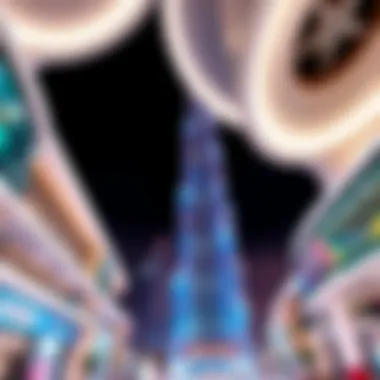

The importance of these initiatives is manifold. They not only address pressing environmental issues but also serve to enhance the store's attractiveness to socially conscious consumers and investors. When we talk about sustainability, we must consider several crucial elements:
- Energy Efficiency: By utilizing advanced energy-efficient systems, the mall can effectively reduce its carbon footprint.
- Water Conservation: Implementing smart water management systems contributes significantly to the overall sustainability of the structure.
- Material Selection: Choosing locally sourced and sustainable materials minimizes transport emissions while promoting local industries.
- Waste Management Programs: Robust recycling and waste reduction initiatives help keep the environment clean and need less landfill space.
The potential benefits of these efforts are substantial. Consumers increasingly prefer businesses that prioritize sustainability. This can lead to increased foot traffic, brand loyalty, and improved public relations. Plus, incorporating green practices can significantly lower operational costs due to reduced utility expenses.
Thus, the Burj Khalifa Shopping Mall isn’t just about luxury shopping; it’s a green pioneer that hopes to inspire similar practices in other commercial spaces.
Eco-Friendly Practices in Design
The design of the Burj Khalifa Shopping Mall integrates sustainability right from the blueprint stage. One notable feature is the facade, constructed with high-performance glass that not only reduces energy consumption but also reflects sunlight effectively, minimizing heat gain inside the mall.
Key Eco-Friendly Practices:
- Natural Ventilation: This minimizes reliance on mechanical systems, allowing for air circulation through carefully planned openings, so fresh air may circulate naturally.
- Green Roofs and Walls: Incorporating vegetation atop certain sections encourages biodiversity while providing insulation and reducing heat island effects.
- Renewable Energy Sources: Utilizing solar panels and wind turbines can help offset energy shortages and is a step towards self-sufficiency.
By embracing these design elements, the mall not only enhances its visual appeal but also its operational efficiency.
Community Engagement and Responsibility
The success of any sustainability initiative hinges on community involvement. The Burj Khalifa Shopping Mall actively engages with local communities to strengthen its sustainability narrative. A sense of ownership is developed, creating a community that cares about the future.
Efforts in Community Engagement Include:
- Workshops and Educational Programs: These types of initiatives inform the local population about sustainability and environmental concerns, driving local action.
- Local Sourcing for Retailers: By promoting local vendors and artisans, the mall bolsters the regional economy while limiting the ecological impact associated with transporting goods over long distances.
- Investment in Local Projects: The mall contributes to local environmental projects, further weaving the web of community responsibility and support.
Technological Innovations
The integration of cutting-edge technology at the Burj Khalifa shopping mall is not just a trend; it’s a pivotal element that shapes the overall shopping experience. In today’s fast-paced world, where customer expectations evolve rapidly, the mall has taken significant strides to embrace digital transformation and smart technologies. These innovations not only enhance consumer interactions but also streamline operations, ensuring a seamless experience for both shoppers and retailers alike.
Digital Transformation in Retail
Digital transformation is rapidly reshaping the retail landscape, and the Burj Khalifa shopping mall stands at the forefront of this movement. Online shopping has pushed physical stores to rethink their strategies. For instance, through mobile apps and interactive kiosks, visitors can access real-time information on promotions, product availability, and store locations. This connectivity enhances the overall shopping experience, allowing customers to make more informed decisions quickly.
To demonstrate, consider a family wandering through the mall. They can pull out their smartphones and, with a few taps, discover what stores are open, find flash sales, or even view customer reviews of products. This level of convenience fosters engagement and can lead to increased spending.
Moreover, retailers in the mall are adopting data analytics to understand shopping behaviors. By examining patterns and preferences, stores can tailor their product offerings. It’s a win-win situation: consumers find products that reflect their interests, while businesses optimize inventory and increase sales efficiency.
Smart Mall Features
The Burj Khalifa shopping mall isn't just about shopping; it's about the experience itself, shaped by several smart features. The use of smart technology can be seen from the moment one steps in. Features such as smart parking systems guide drivers to available spaces in real-time, eliminating the usual hassle of searching for a spot.
Furthermore, sensor-based lighting adjusts according to foot traffic, providing energy savings and enhancing the atmosphere. Imagine stepping into a beautifully lit corridor that brightens as you approach, creating a welcoming ambiance.
Other prominent smart features include:
- Augmented Reality (AR): This technology allows shoppers to visualize products in their own homes or see additional product information through their devices.
- Smart security systems: Surveillance cameras equipped with AI help ensure safety, monitoring unusual behaviors and alerting authorities when necessary.
- Wi-Fi access: Free high-speed internet throughout the mall enhances connectivity, allowing users to stay engaged while they shop.
These innovations reflect a shift towards creating an environment where technology not only assists but also enriches the customer journey, aligning perfectly with modern retail demands.”
Closure
The conclusion is pivotal to the article, encapsulating the myriad insights discussed while driving home the overarching significance of the Burj Khalifa Shopping Mall. This mall is not just a retail space; it represents a profound junction of culture, commerce, and cutting-edge architectural ambition. In a world that increasingly values experience over mere consumption, the Burj Khalifa Shopping Mall stands tall—both literally and metaphorically—as a symbol of how commercial spaces can provide unforgettable consumer experiences.
Reflection on Consumer Experience
Consumer experience at the Burj Khalifa Shopping Mall is distinctly crafted to enchant visitors. It's more than just about shopping; it’s about immersing oneself in a multifaceted environment. Each entrance invites intrigue, thanks to the mall’s strategic layout and enchanting aesthetics. Here, visitors aren't just passive participants; they engage actively with their surroundings. From lavish window displays that entice onlookers to interactive digital kiosks that inform and entertain, every element fosters an engaging atmosphere.
Understanding how consumers behave in this environment is crucial. The layout promotes a natural flow, ensuring that foot traffic moves seamlessly through various high-end boutiques, dining establishments, and experiential zones. Shoppers veer from one brand to another, often led by a sensory overload of sights and sounds. This curated experience caters to a unique blend of local and international consumers, each seeking something different yet equally thrilling.
The Burj Khalifa Shopping Mall lifts consumer engagement to an art form. It emphasizes the essential nature of service and ambiance, alongside product offerings. As word of mouth spreads about these stellar interactions, they contribute to a strong community image, driving traffic further.
Future of Retail in Iconic Locations
Looking ahead, the future of retail in iconic locations like the Burj Khalifa Shopping Mall is brimming with potential. Retail spaces are evolving to meet the demands of digital-savvy consumers who come expecting more than just a shopping spree. With global trends favoring experiences over traditional shopping, this mall is ideally positioned to adapt its offerings.
Innovative technology will undoubtedly play a role in this evolution. As augmented reality and artificial intelligence become mainstays in the retail narrative, expect to see more seamlessly integrated features within shopping experiences.
Moreover, sustainability is emerging as a non-negotiable element aligned with consumer values. A focus on eco-friendly practices and community responsibility may very well shape future developments. As such, developers and investors must embrace these changes, ensuring that iconic spaces resonate with contemporary values.
The Burj Khalifa Shopping Mall could serve as a model to set the standard for future retail environments, reflecting the changing dynamics of consumer engagement. Investors and stakeholders must remain vigilant and responsive to these shifts to harness the potential that lies within such monumental retail spaces.
"The integration of innovative technology and a focus on experiential retail will redefine how we engage with malls, particularly those in awe-inspiring venues like the Burj Khalifa."
This concludes the exploration of the Burj Khalifa Shopping Mall, a dialogue between past experiences and future possibilities.



